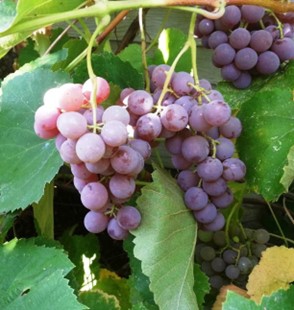Grapes
Grapes
Growing your own grapes is EASY!
Grapes
What you’ll need: Grape Plants
T&C Soil Enhancer Fertilome Root Stimulator
Optional: Save-a-Tree
Soil Sulfur

Step 1: Choose variety. Choose a variety that is hardy for east Idaho. See back for recommended varieties. Seedless for eating. Seeded for juice.
Step 2: Keep moist until planted.
If potted– fill the top of each pot with water. Allow to soak in. Water daily until planted. If bare root– keep roots in plastic bag away from direct sunlight to keep moist. Plant within 48 hours if possible.
Step 3: Dig hole at least twice as wide as root ball, but no deeper than necessary to accommodate roots.
Step 3: Plant in a sunny location. Against a south facing wall works well.
If potted– remove from pot. Plant at same depth as it was growing in the pot.
If bare root– place roots in their natural position. Do not “squish” roots to fit hole.
Step 3: Backfill with soil mixed 50/50 with T&C Soil Enhancer. Optional: also mix soil sulfur into backfill- 2 tbsp. per 12” wide hole, 4 tbsp. per 18” hole, 8 tbsp. per 24” hole.
Step 4: Water in with Fertilome Root Stimulator solution according to directions on bottle.
Step 5: Watch them grow. Water only when soil appears dry on surface. If plant is dormant (no leaves) it won’t need much water until it leafs out and begins to grow. Be patient. Grapes are one of the last things to leaf out in spring.
Step 6: Feed with Save-a-Tree two weeks after planting. Thereafter feed twice yearly in May and October with Save-A-Tree or T&C Fruit & Flower Food.
Pruning
Grapes will grow and produce with little pruning, but they can become unwieldy as they grow up to 10 feet per year. They will produce best when trained as shown below.

Stretch two stout wires between two posts that have been spaced ten feet apart. The top wire is tightly strung about five feet off the ground, and the second about two feet. The grape vine is planted between the two posts. Over time a strong central trunk is trained with only four arms, or branches, growing out of it.
After planting, prune the vine back so that only two buds are left above ground. This may seem a little drastic, but it is helpful in developing a strong central trunk and a healthy grape plant. When new canes have grown out from the buds and are about two feet long, choose the strongest one and fasten it loosely to the end of a string. Tie this to the top wire. This will lead the cane straight up so that it will become the trunk and lateral canes will grow from it to form the four arms.
Grape Varieties
Although many grape varieties will not survive our severe Idaho winters, there are a few varieties that can do very well here. Seedless grapes are worth trying if you have a protected area to plant them in. Grapes can also make excellent decorative vines for the landscape.
Grapes are harvested in the fall.
| Variety | Hardi- ness | Description |
| Seedless | ||
| Canadice | -20 F. | An early red variety ripening two weeks before Concord. Fruit clusters compact and large. Best of all red seedless varieties. |
| Concord Seedless | -20 F. | Seedless blue-black grape for fresh eating. Also wonderful for juices and jellies. Nice sized clusters of large grapes. Seedless. |
|
Himrod |
-20 F. |
One of the hardiest white seedless grapes. Long loose clusters of medium sized yellow-gold fruit. Ripens a month earlier than Concord. A very high quality seedless white variety. Excellent for table use. |
| Reliance | -20 F. | Seedless red grape for fresh eating. Wonderful for juices and jams. Medium sized clusters are ready to harvest mid-season. |
| Seeded | ||
|
Valiant |
-40 F. |
Hardiest grape. Fruit smaller than concord, but very flavorful and productive. Excellent for juices and jellies. Berries seeded and round, up to ½” in
diameter. Skin does not adhere to flesh. |
| Concord | -20 F. | Blue-black, excellent for eating, jam, jelly, and juice. Medium to large clusters. Berry size is medium to large. Vigorous. Seeded. |


